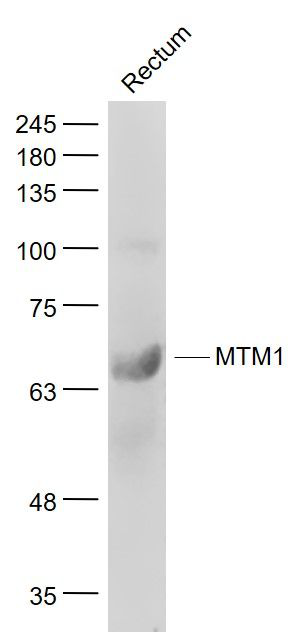产品货号 : mlR9178
英文名称 : MTM1
中文名称 : 肌微管素1抗体
别 名 : CG2; CNM; KIAA4176; mKIAA4176; Mtm; Mtm1; MTM1_HUMAN; MTMX; Myotubular myopathy 1; Myotubularin; XLMTM.
研究领域 : 肿瘤 细胞生物 免疫学 信号转导 干细胞 细胞周期蛋白 激酶和磷酸酶 细胞分化
抗体来源 : Rabbit
克隆类型 : Polyclonal
交叉反应 : Human, Mouse, Rat, Dog, Pig, Rabbit,
产品应用 : WB=1:500-2000 ELISA=1:500-1000 IHC-P=1:400-800 IHC-F=1:400-800 IF=1:50-200 (石蜡切片需做抗原修复)
not yet tested in other applications.
optimal dilutions/concentrations should be determined by the end user.
分 子 量 : 70kDa
细胞定位 : 细胞浆 细胞膜
性 状 : Lyophilized or Liquid
浓 度 : 1mg/ml
免 疫 原 : KLH conjugated synthetic peptide derived from human MTM1/Myotubularin:201-300/603
亚 型 : IgG
纯化方法 : affinity purified by Protein A
储 存 液 : 0.01M TBS(pH7.4) with 1% BSA, 0.03% Proclin300 and 50% Glycerol.
保存条件 : Store at -20 °C for one year. Avoid repeated freeze/thaw cycles. The lyophilized antibody is stable at room temperature for at least one month and for greater than a year when kept at -20°C. When reconstituted in sterile pH 7.4 0.01M PBS or diluent of antibody the antibody is stable for at least two weeks at 2-4 °C.
PubMed : PubMed
产品介绍 : X-linked recessive myotubular myopathy is a congenital muscular disease characterized by severe hypotonia and generalized muscle weakness that, in most cases, leads to early postnatal death. The gene responsible for myotubular myopathy MTM1 encodes a dual specificity phosphatase, named myotubularin, which is highly conserved through evolution. The gene for MTM1 is localized to a 300 kb critical region on human Xq128 between IDS and GRBRA3. Human MTM1, a 603 amino-acid protein, is mutated in myotubular myopathy. The largely related protein hMTMR2 is found mutated in a recessive form of Charcot-Marie-Tooth neuropathy. Myotubularin is primarily a lipid phosphatase that acts on phosphatidylinositol 3-monophosphate and is involved in the regulation of the phosphatidylinositol 3-kinase (PI3-kinase) pathway and membrane trafficking. Wild-type myotubularin can directly dephosphorylate PI3P and PI4P in vitro. Thus, it decreases PI3P levels by down-regulating PI3K activity and by facilitating the degradation of PI3P.
Function:
Lipid phosphatase which dephosphorylates phosphatidylinositol 3-monophosphate (PI3P) and phosphatidylinositol 3,5-bisphosphate (PI(3,5)P2). Has also been shown to dephosphorylate phosphotyrosine- and phosphoserine-containing peptides. Negatively regulates EGFR degradation through regulation of EGFR trafficking from the late endosome to the lysosome. Plays a role in vacuolar formation and morphology. Regulates desmin intermediate filament assembly and architecture. Plays a role in mitochondrial morphology and positioning. Required for skeletal muscle maintenance but not for myogenesis.
Subunit:
Interacts with MTMR12; the interaction modulates MTM1 intracellular localization. Interacts with MLL (via SET domain). Interacts with DES in skeletal muscle but not in cardiac muscle.
Subcellular Location:
Cytoplasm. Cell membrane; Peripheral membrane protein. Cell projection, filopodium. Cell projection, ruffle. Late endosome. Note=Localizes as a dense cytoplasmic network. Also localizes to the plasma membrane, including plasma membrane extensions such as filopodia and ruffles. Predominantly located in the cytoplasm following interaction with MTMR12. Recruited to the late endosome following EGF stimulation. [DOMAIN] The GRAM domain mediates binding to PI(3,5)P2 and, with lower affinity, to other phosphoinositides.
DISEASE:
Defects in MTM1 are the cause of centronuclear myopathy X-linked (CNMX) [MIM:310400]. A congenital muscle disorder characterized by progressive muscular. weakness and wasting involving mainly limb girdle, trunk, and neck muscles. It may also affect distal muscles. Weakness may be present during childhood or adolescence or may not become evident until the third decade of life. Ptosis is a frequent clinical feature. The most prominent histopathologic features include high frequency of centrally located nuclei in muscle fibers not secondary to regeneration, radial arrangement of sarcoplasmic strands around the central nuclei, and predominance and hypotrophy of type 1 fibers.
Similarity:
Belongs to the protein-tyrosine phosphatase family. Non-receptor class myotubularin subfamily.
Contains 1 GRAM domain.
Contains 1 myotubularin phosphatase domain.
SWISS:
Q13496
Gene ID:
4534
Important Note:
This product as supplied is intended for research use only, not for use in human, therapeutic or diagnostic applications.
产品图片












